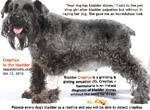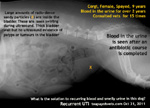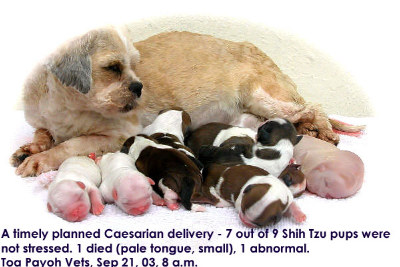Dietary management to
dissolve struvite stones in the bladder & voiding
urohydropropulsion
Dr Sing Kong Yuen, BVMS (Glasgow), MRCVS
Written: Perth,
29 September 2010
Update: 11 December 2011 |
 toapayohvets.com toapayohvets.com
Be Kind To Pets
Veterinary Education
Project 2010-0129 |
 After the surgical removal of the struvite urinary stones
or for medical and dietary treatment, how much of the
prescription diet should the owner give the dog/day?
I took some time just to read about Canine Struvite
Urolithiasis case studies in the sleep-inducing thick book "Small Animal
Clinical Nutrition" by Hand et. al, 5th Edition
while on holiday in Perth, Australia. The
following is some general guideline for Toa Payoh Vets in
advising on Prescription Diet s/d to dogs based on 3 case
studies in the book. After the surgical removal of the struvite urinary stones
or for medical and dietary treatment, how much of the
prescription diet should the owner give the dog/day?
I took some time just to read about Canine Struvite
Urolithiasis case studies in the sleep-inducing thick book "Small Animal
Clinical Nutrition" by Hand et. al, 5th Edition
while on holiday in Perth, Australia. The
following is some general guideline for Toa Payoh Vets in
advising on Prescription Diet s/d to dogs based on 3 case
studies in the book.
|
How much of the s/d diet to be given?
1. Puppy
X-breed, 9 weeks,
5 kg. |
700kcal
(2.83MJ) |
1/2 can
3x/day |
|
2.
Rottweiler, 5 years, 41 kg |
1,800kcal
(7.5MJ) |
1.5 cans
2x/day |
|
3. German
Shepherd, 12 years, 27 kg |
1,150kcal
(4.8MJ) |
1 can
2x/day |
Other procedures to ensure compliance from the
owner:
1. Antibiotics from 14-30 days and review
using urine cultures
2. Monthly urine analysis (check for UTI) and
blood tests (esp. serum urea nitrogen,
magnesium, phosphorus and calcium and alkaline
phosphatese)
3. Monthly x-rays of kidney (V/D view), bladder
(lateral views).
Back to normal
commercial food for the puppy as soon as X-rays
show no stones. For adult dogs, give prescription
food for one more month
after
negative X-ray results. No commercial dog treats or
snacks during the period of treatment. In
practice, I advise initially 3 months of the S/D
diet and get urine tests done monthly in most cases.
The Singapore dog owner seldom complies with the
above-mentioned procedures or with monthly urine
tests!
Till blood in the urine returns!
RECURRENT UTI
Specialised
tests like double-contrast cystography (to check
out anatomic abnormalities of the bladder,
obstruction of urine flow from kidneys), retrograde
positive-contrast urethrocystography (to check out
anatomical abnormalities of the urinary tract to the
prostate gland area, bladder tumours) if there is
recurrent
uroliths or UTI (see case study of the old Corgi
with recurrent UTI).
 |
|
|
Recurrent UTI in an old Corgi - Part 1
http://www.sinpets.com/dogs/20111044blood-urine-recurs-over10times-old-corgi-female-toapayohvets.htm |
 |
|
Recurrent UTI in an old Corgi - Part 2
http://www.sinpets.com/F6/
20111210recurrent-urinary-tract-infection-old-female-spayed-corgi-singapore-toapayohvets.htm |
|
|
Voiding
urohydropropulsion is used in cases where the uroliths are
small. The owner must be informed that it takes 2-4 months
or longer to get all struvite stones dissolved. The owner
must be aware of the need for reviews and to note the
costs involved in the dietary management to dissolve
struvite urinary stones.
VETERINARY SURGERY
--- VOIDING UROHYDROPROPULSION IN DOGS AND CATS
What is urohydropropulsion?
Basically it means pumping saline into the bladder
(3ml/kg) and suck out the fluid together with the small
uroliths (urinary stones) with a catheter. The stones in
the bladder are too small and therefore no surgical
removal is needed.
ANAESTHESIA. May or may not be need. Two methods described in Small Animal Clinical
Nutrition 5th edition.
POSITION 1. Hold the dog or cat upright so that the
vertebral column is upright. The urine and stones will
be at the bottom (neck) of the bladder.
POSITION 2. Lateral recumbency.
In both positions, catheterise, irrigate with saline
(3ml/kg), massage or press bladder to shake up the
stones, suck out the saline + stones with a syringe.
X-rays to check if all are taken out but not all small
ones can be seen.
Dietary and medical treatment.
More information is at: Small Animal Clinical Nutrition"
by Hand et. al, 5th Edition.
This webpage:
http://www.sinpets.com/F5/20100697struvite-dietary-management-voiding-urohydropropulsion_ToaPayohVets.htm |
|
|
|
Advertisement |
|
|
|
 More
info at:
Dogs or
Cats More
info at:
Dogs or
Cats
To make an appointment:
e-mail
judy@toapayohvets.com
tel: +65 9668-6469, 6254-3326 |
 toapayohvets.com toapayohvets.com
Be Kind To Pets
Veterinary Education
Project 2010-0129 |
|
|
 TOA
PAYOH VETS
TOA
PAYOH VETS TOA
PAYOH VETS
TOA
PAYOH VETS